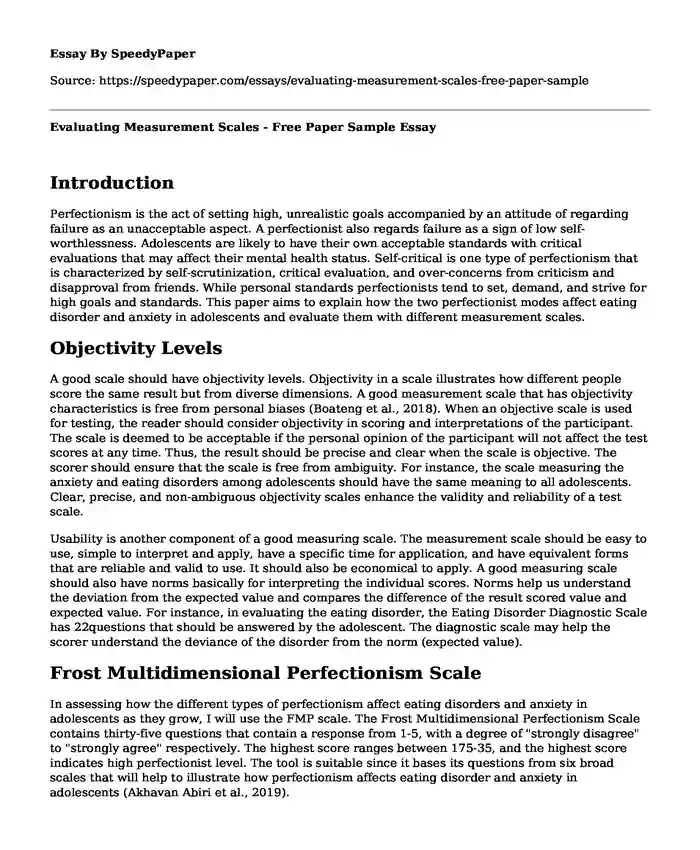
| Type of paper: | Essay |
| Categories: | Psychology Personality Anxiety disorder |
| Pages: | 3 |
| Wordcount: | 722 words |
Introduction
Perfectionism is the act of setting high, unrealistic goals accompanied by an attitude of regarding failure as an unacceptable aspect. A perfectionist also regards failure as a sign of low self-worthlessness. Adolescents are likely to have their own acceptable standards with critical evaluations that may affect their mental health status. Self-critical is one type of perfectionism that is characterized by self-scrutinization, critical evaluation, and over-concerns from criticism and disapproval from friends. While personal standards perfectionists tend to set, demand, and strive for high goals and standards. This paper aims to explain how the two perfectionist modes affect eating disorder and anxiety in adolescents and evaluate them with different measurement scales.
Objectivity Levels
A good scale should have objectivity levels. Objectivity in a scale illustrates how different people score the same result but from diverse dimensions. A good measurement scale that has objectivity characteristics is free from personal biases (Boateng et al., 2018). When an objective scale is used for testing, the reader should consider objectivity in scoring and interpretations of the participant. The scale is deemed to be acceptable if the personal opinion of the participant will not affect the test scores at any time. Thus, the result should be precise and clear when the scale is objective. The scorer should ensure that the scale is free from ambiguity. For instance, the scale measuring the anxiety and eating disorders among adolescents should have the same meaning to all adolescents. Clear, precise, and non-ambiguous objectivity scales enhance the validity and reliability of a test scale.
Usability is another component of a good measuring scale. The measurement scale should be easy to use, simple to interpret and apply, have a specific time for application, and have equivalent forms that are reliable and valid to use. It should also be economical to apply. A good measuring scale should also have norms basically for interpreting the individual scores. Norms help us understand the deviation from the expected value and compares the difference of the result scored value and expected value. For instance, in evaluating the eating disorder, the Eating Disorder Diagnostic Scale has 22questions that should be answered by the adolescent. The diagnostic scale may help the scorer understand the deviance of the disorder from the norm (expected value).
Frost Multidimensional Perfectionism Scale
In assessing how the different types of perfectionism affect eating disorders and anxiety in adolescents as they grow, I will use the FMP scale. The Frost Multidimensional Perfectionism Scale contains thirty-five questions that contain a response from 1-5, with a degree of "strongly disagree" to "strongly agree" respectively. The highest score ranges between 175-35, and the highest score indicates high perfectionist level. The tool is suitable since it bases its questions from six broad scales that will help to illustrate how perfectionism affects eating disorder and anxiety in adolescents (Akhavan Abiri et al., 2019).
Conclusion
The scale measures "personal standards (PS), Parental Expectations (PE), Parental Criticism (PC), Doubts about Actions (DA), Concern over Mistakes (CM), and Personal Organization (PO)" (Gavino et al., 2019). The PS will illustrate the high standards the adolescent may set and how he/she may attain them. The PE and PC will define the goals of parents and their expectations upon their adolescents. The DA will explain the personal fear about their ability to do something. The CM will contain questions based on individual concerns on failure and the negative views of failure from others. The PO will explain the excessive attention given to living orderly by the adolescent. A high score of 175 illustrates a high level of perfectionism, while the least score of 35 shows a low level of perfectionism.
References
Akhavan Abiri, F., Shairi, M. R., & Gholami Fesharaki, M. (2019). The investigation of psychometric properties of the Frost Multidimensional Perfectionism Scale (FMPS). Sheik journal of psychology & Psychiatry, 6(1), 87-106. http://shenakht.muk.ac.ir/article-1-604-en.html
Boateng, G. O., Neilands, T. B., Frongillo, E. A., Melgar-Quiñonez, H. R., & Young, S. L. (2018). Best practices for developing and validating scales for health, social, and behavioral research: a primer. Frontiers in public health, 6, 149. https://www.frontiersin.org/articles/10.3389/fpubh.2018.00149/full
Gavino, A., Nogueira, R., Pérez-Costillas, L., & Godoy, A. (2019). Psychometric properties of the Frost Multidimensional Perfectionism Scale in Spanish children and adolescents. Assessment, 26(3), 445-464. https://journals.sagepub.com/doi/abs/10.1177/1073191117740204.
Cite this page
Evaluating Measurement Scales - Free Paper Sample. (2023, Nov 25). Retrieved from https://speedypaper.net/essays/evaluating-measurement-scales-free-paper-sample
Request Removal
If you are the original author of this essay and no longer wish to have it published on the SpeedyPaper website, please click below to request its removal:
- Free Paper Sample with a Stress Lab Report
- Free Essay on Handling a Job Application and Business Legal Compliance
- Problem Statement about Equity in Education
- Essay Example on Being a Responsible Person and Leader
- Essay Sample on Women and Work
- Free Essay Example. My Leadership Skills
- Free Paper Sample: Depression and Anxiety in Relation to Sports Psychology
Popular categories




